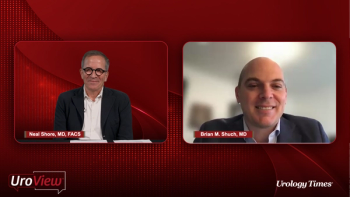
Overactive Bladder Prevalence and Impact
Dr Alex Rogers and Dr Scott MacDiarmid discuss overactive bladder (OAB) prevalence and diagnosis and its impact on quality of life.
Episodes in this series

Alexandra Rogers, MD: Hello, and welcome to this UroView™ video about implantable tibial nerve stimulation devices for the treatment of overactive bladder [OAB]. I’m Dr Alex Rogers, from Sansum Clinic in Santa Barbara, California, where I take care of a high volume of patients with overactive bladder. I’m committed to improving awareness and access to the best incontinence therapies through early adoption, adaptation, and accountability by tracking my therapy trends.
Joining me in this discussion is my lovely Canadian friend, colleague, and mentor, Dr Scott MacDiarmid. As a Wake Forest University medical student, we studied the safety of anticholinergics in men with overactive bladder, and years later, both participated in the pivotal eCoin trial. Dr Scott MacDiarmid is a partner at Alliance Urology Specialists in Greensboro, North Carolina. He’s a clinical associate professor in the department of urology at the University of North Carolina. In today’s discussion, we’ll review the overactive bladder landscape and discuss tibial implant device data along with updates in this featured space. Let’s get started.
Scott, can you briefly describe overactive bladder, its prevalence, and its impact on quality of life?
Scott MacDiarmid, MD, FRCPSC: Thanks, Alex. Before I start, it’s great to see you again. When Alex says I’m her mentor, that means I’m old enough to be her father, luckily not her grandfather. I grew up in Halifax, Nova Scotia, and Dalhousie University just sent me a reminder that it’s been 40 years since I graduated.
We’re going to talk about overactive bladder. Our audience knows that it’s urgency plus frequency plus or minus urgent incontinence and nighttime frequency. We’ve all heard this. But urgency is the driving symptom, because if you have urgency, you have frequency. If you have urgency and you don’t get there in time, you leak, you have urgent incontinence. It gets you up in the middle of the night as well.
Millions have it. We use a lot of the common data, but it’s important, 30 million or 40 million Americans suffer from overactive bladder when they get over 40 years of age. The prevalence increases as you get older, even though it’s not normal to have it when you’re older. Alex, it’s always interesting, I remember when I first saw the data, it looked almost as common in men as in women, and I thought, “OK, now that makes sense.” It’s for this reason. If a man has frequency and urgency and you sell an alpha blocker, you say that patient has BPH [benign prostatic hyperplasia]. You’re regulated to call them that. If you sell an OAB medicine, you say they have overactive bladder. But it’s the same man, so it’s more of a nomenclature. You can see why men catch up in the older years in terms of the prevalence. The bottom line is they’re in our waiting room every day and need our help. Between overactive bladder, kidney stones, and prostate cancer, that’s urology. There are so many patients.
I used to do some work on quality of life. I’ve interviewed people and written a little about it. There’s no question that people lose their self-esteem and are embarrassed. It’s associated with anxiety and depression. It’s amazing what men and especially women will avoid when they have this problem. They avoid traveling. They avoid going to their grandchild’s wedding. They avoid exercising. You can imagine why they might avoid intimacy. It’s a shame. This is an important part of this discussion regarding new treatments, because the more you realize how negatively affected people are, the more likely you are to screen and diagnose at primary care, along with more patients being treated and referred. But to our fellow urologist and urogynecologist, set your treatment goals high. We’ll be talking about the OAB pathway. With reasonable expectations—you have to always balance that—try to drive excellence and help these patients as much as possible.
What are your thoughts overall, especially with primary care in the realm? Maybe give some general comments on how this gets diagnosed in the trenches, not necessarily the test, but who’s doing it and what the patients’ perspectives are of things.
Alexandra Rogers, MD: In regard to diagnosis, clearly it’s just too late. Half of women wait over a year to seek help from a professional. On average, most are waiting over 3 years from symptom onset to try to obtain help. The lag is clearly multifactorial, given this is wrongfully stigmatized and perceived as shameful. Half of women are embarrassed to say anything to a professional, and 44% of health care professionals don’t ask about this awkward condition. Even when they finally see someone like us, all they know is that they have leakage and often believe that highly polluting incontinence products are their option, or some medication prescribed years ago that they quit because it had such drying adverse effects. The maze to diagnosis is full of roadblocks, and when they finally reach us, their incontinence needs to be clearly defined, both verbally and with care pathways, given that many women have both, and we need to tackle the most bothersome symptom. Diagnosis is a mess.
Transcript edited for clarity.
Newsletter
Stay current with the latest urology news and practice-changing insights — sign up now for the essential updates every urologist needs.



